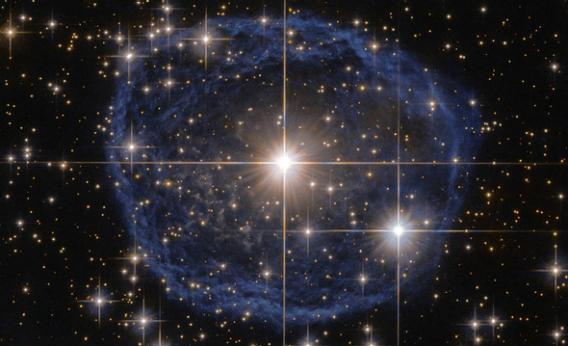Create a free profile to get unlimited access to exclusive videos, sweepstakes, and more!
A Blue Bubble That Isn’t

Gaze upon this gorgeous Hubble image of the nebula surrounding the star WR 31a but be warned: What you’re seeing is not what you get!
First things first. The star WR 31a is what’s called a Wolf-Rayet (or WR) star. These come in a variety of flavors, but most of them are extremely massive, hot, and luminous. And I’m not fooling around here: They start at 20 or more times the mass of the Sun, are five to 40 times hotter, and can be millions of times more luminous.
These are stars nearing the ends of their lives. They’ve already run out of hydrogen in their cores to fuse into helium, and are now fusing helium (or heavier elements) to create energy. Between those two stages in a massive star’s life it becomes a red supergiant, and a natural consequence of them blasting out so much energy is that they’ve shed their outer layers; octillions of tons of hydrogen blown away into space by the vast energies brewing underneath.
This exposes the hotter and brighter layers that used to be deep inside the star. This can illuminate the expelled gas, creating a beautiful nebula around the star. This is similar to a planetary nebula, when a star with lower mass blows off its outer layers, exposing the core, which excites the expelled gas, causing it to glow literally like a neon sign. For WR stars, the gas isn’t glowing but reflecting the star’s light, making them what are called protoplanetary nebulae.
That’s the case in WR 31a. The beautiful wisps and tendrils you see used to be a part of the star but have been thrown off in a dense stellar wind. The gas is being lit by the star itself at the center. And just to give you a sense of scale, that structure is about nine light-years across: 90 trillion kilometers. On this scale, our entire solar system would be invisibly small.
But have a care here! The nebula is being called a “blue bubble,” but it’s not really blue. Kinda.
This image was taken using two different filters on Hubble Advanced Camera for Surveys. What’s colored red in the image is actually from the near-infrared, light our eyes don’t see, but to which ACS is sensitive. What you see colored blue in the image is actually from a filter that lets through light from the green part of the spectrum out into the red. The color used to display the light from that filer in the photo is more of an artistic choice than a physical one; they could’ve chosen green or orange or yellow. That’s arbitrary.
The funny thing is, in this case that filter actually blocks blue light. In other words, of all the colors the human eye can see that this gas is sending toward us, blue is the only one not really shown in the image! And it does reflect blue light; in fact, many such reflection nebulae appear blue to the eye.
The structure is interesting though. What you’re seeing is a shell of material, like a soap bubble. It’s not really a ring, it’s just that near the edges you’re looking through more material, and that makes it look like a ring. However, I noticed what looks like a faint elliptical ring inside the outer ring, and I suspect that might actually be a real ring, a flat annulus of material. You can see it a bit more clearly in this infrared view from the Spitzer Space Telescope:
Those inner rings can form when stars spin rapidly, which causes them to throw out a more flattened stream of material due to centrifugal force. The outer ring is slightly elongated, and the long axis is perpendicular to the inner ring as well, which is consistent. Material flowing out from the star hits that equatorial ring and slows down, but stuff expanding along the poles is free to move outward, so the resulting nebula can be egg-shaped. That’s pretty common too.
I’m not claiming this is exactly what’s happening in WR 31a—the evidence is faint—but it looks like that’s a possibility to my eye … and in my defense, I studied objects like this for many years. I poked around the professional journals but didn’t see a lot about it. Hopefully more observations of this star will be done.
And one more image: I found this WISE (Wide-field Infrared Survey Explorer) image of WR 31a that caught my attention:
Look how much rounder it appears! WISE sees in the far infrared, where dust (very small grains of silicates and carbon) glows brightly. You can even tell the nebula is a bubble, and not a filled sphere; the center is darker than the outer edge. Pretty nifty. Incidentally, that dust was probably created when the star was a red supergiant. That process creates a lot of dust, so seeing it here is consistent with the overall picture.
All in all, this is a fascinating object. We’re seeing a star in the very short period between it living a normal life and exploding as a supernova. And that is the eventual fate of WR 31a, have little doubt. At a distance of 30,000 light-years, it’ll be pretty bright, about as bright as Venus in the night sky … though since it’s in the constellation of Carina, you’ll have to be pretty far south to see it. It may have a few dozen (or hundred!) millennia left to go before any of that happens anyway, so don’t plan your trip to Australia just yet.
Until then, just enjoy this wonderful imagery, and marvel at what treasures the Universe shows us.


























